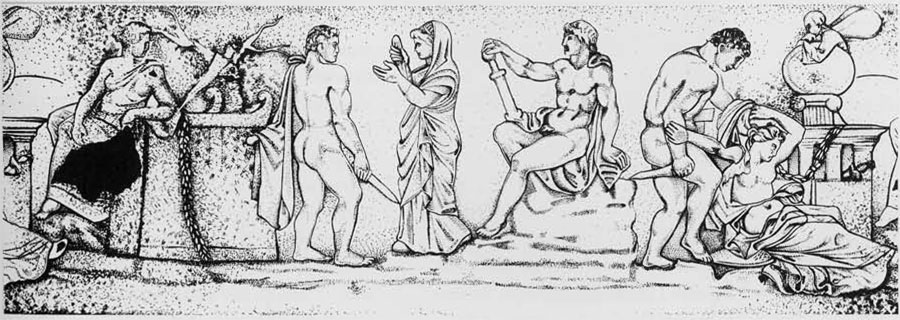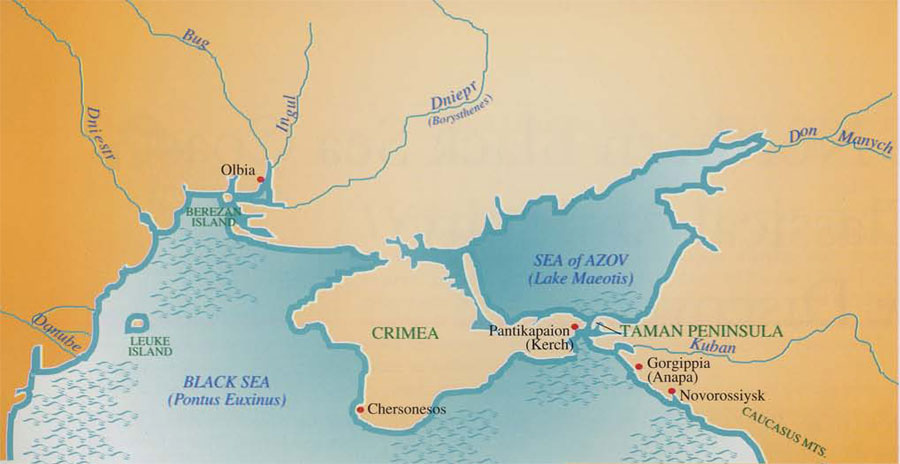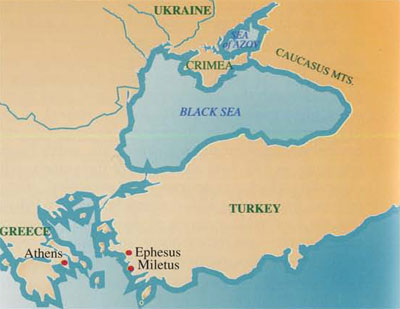
THE NORTHERN BLACK SEA LITTORAL was considered by both ancient and contemporary, scholars to exist on the remotest peripheries of the Greek world. Yet it never degenerated into a backward or semi-barbaric province of the great Hellenic civilization. On the contrary, its fate was closely intertwined with that of the whole ancient world. Its development passed through the same stages and gave birth to the same phenomena as the poleis (city-states) of the Mediterranean and the Black seas. Nevertheless, this parallel development did not deprive the north Pantie city-states, as they were also called, of their unique self-expression, which was determined by ecological, ethnopolitical, and specific historical conditions. We believe that the immutable meaning of the region for general Greek history—and ancient history as a whole—is rooted in this harmonious, indivisible interlacing of the general and the specific.
It is not difficult to find the reasons for this dialectical harmony. The great fundamental moment that brought about Hellenism was its contact, from its very first steps to its final breath, with a huge and varied world of outsiders. Hellenism civilized the northern shores of the Pontus Euxinus, along with its brotherhoods in Asia Minor and the Greek mainland, in Gaul and Spain, and in Libya and Egypt. This relationship, over the course of many centuries, determined the character of the northern Black Sea city-states as well as the surrounding areas. The second great moment, inherent to many regions of Greek colonization, consisted of access to vast natural resources, which, during the initially favorable ethnopolitical environment, led to a sharp rise in the local economy. The latter, in its turn, caused significant differentiation among the inhabitants of the city-states, at first in economic, and then in social and legal ways.

The particular character of the historical development of the Hellenic states of the northern Black Sea area was influenced by the fact that, over the course of some five centuries, down to the Roman era, they were never subject to the strong despotisms of the ancient Near Eastern type. They were not part of Alexander the Great’s empire, and after its collapse, were not integrated into any of the Hellenistic monarchies that developed from its ruins. This certainly does not mean that the Greeks who lived on the northern shore of the Black Sea remained autonomous during this entire period. Quite the opposite. Here, as in neighboring regions, there developed a unique form of dependence that could be called a barbarian protectorate.

In accord with these ideas, which were formulated by Russian specialists in the ancient world, the editors of this special issue of the Expedition Magazine wish to acquaint the Western reader with the most striking and original discoveries of the last several years in the northern area of the Black Sea. Even more, they aim to render at least a rough image of the political and cultural symbiosis that took place between two great ancient civilizations—Greek and non-Greek—which has enriched universal history and culture. Gregory M. Bongard-Levin and Yuri G. Vinogradov
Note from the Editor
This issue is an unusual one for Expedition, and one we have enjoyed producing. We are most grateful to the group of scholars in Moscow who shared their exciting new work with us. We are also grateful to Guest Editor Prof. Gregory Bongard-Levin for proposing the theme in the first place, and for his long-distance efforts at facilitating publication of the articles. We are pleased that the Center for Comparative Studies of Ancient Civilizations, Russian Academy of Sciences has made this issue possible.
The articles were submitted in Russian and translated here by Lada Onyshkevych, a Ph.D. candidate in Classical Archaeology at the University of Pennsylvania. (Onyshkevych has excavated in Ukraine; her dissertation topic is on the graffiti from Olbia and Berezan.) Dr. Henry Michael, Senior Fellow in Dendrochronology at the University of Pennsylvania Museum, served as Senior Consultant on the translation. We thank them both for their aid. The transliteration is a simplified version of that used by the US Board on Geological Names; it was used in part for consistency with the recent survey article in the American journal of Archaeology by Treister and Yuri G. Vinogradov (1993; see Vinogradov’s bibliography, this issue). Readers may wish to turn to this article for further information on current archaeological research on the northern coast of the Black Sea. L.H.
